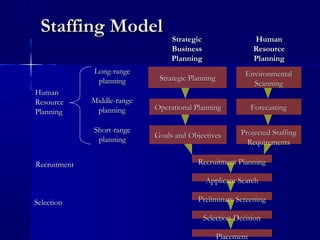Chapter 3.1
- 1. Chapter 3: Human ResourceChapter 3: Human Resource Planning, Recruitment, andPlanning, Recruitment, and SelectionSelection Creating Effective OrganizationsCreating Effective Organizations
- 2. Development of HumanDevelopment of Human Resource ManagementResource Management Parallels the protection and treatment of workersParallels the protection and treatment of workers 1.1. Social Welfare DepartmentSocial Welfare Department 1880 – 19351880 – 1935 a.a. Helping injured workers and their familiesHelping injured workers and their families b.b. Company unions: parties and social eventsCompany unions: parties and social events c.c. Worker healthWorker health 2.2. Labor Relations DepartmentLabor Relations Department 1935 – 19501935 – 1950 a.a. Collective bargainingCollective bargaining b.b. Contract administrationContract administration 3.3. Industrial Relations DepartmentIndustrial Relations Department 1950 – 19701950 – 1970 a.a. Labor relationsLabor relations b.b. Benefits and vacationsBenefits and vacations c.c. Testing and selectionTesting and selection d.d. Compensation systemsCompensation systems 4.4. Personnel DepartmentPersonnel Department 1970 – 19901970 – 1990 a.a. Legal complianceLegal compliance b.b. StaffingStaffing c.c. Performance evaluationPerformance evaluation d.d. Compensation and benefitsCompensation and benefits e.e. Employee relationsEmployee relations f.f. Safety and healthSafety and health 4.4. Human Resource ManagementHuman Resource Management
- 3. Staffing ModelStaffing Model Strategic PlanningStrategic Planning EnvironmentalEnvironmental ScanningScanning Operational PlanningOperational Planning ForecastingForecasting Projected StaffingProjected Staffing RequirementsRequirements Goals and ObjectivesGoals and Objectives Recruitment PlanningRecruitment Planning Applicant SearchApplicant Search Preliminary ScreeningPreliminary Screening Selection DecisionSelection Decision PlacementPlacement StrategicStrategic BusinessBusiness PlanningPlanning HumanHuman ResourceResource PlanningPlanning Long-rangeLong-range planningplanning SelectionSelection RecruitmentRecruitment Middle-rangeMiddle-range planningplanning Short-rangeShort-range planningplanning HumanHuman ResourceResource PlanningPlanning
- 4. Typical Steps in the Selection ProcessTypical Steps in the Selection Process Reference checksReference checks Employment testingEmployment testing Drug testingDrug testing Final interviewFinal interview Selection decisionSelection decision Placement on the jobPlacement on the job Reject applicantReject applicantPreliminary screeningPreliminary screening Application blanksApplication blanks InterviewsInterviews
- 5. Forecasting EmploymentForecasting Employment NeedsNeeds 1.1. BudgetingBudgeting 2.2. Work-load AnalysisWork-load Analysis 3.3. Unit DemandUnit Demand 4.4. Expert OpinionExpert Opinion 5.5. Trend PredictionsTrend Predictions
- 6. Solving the ‘Surplus Personnel’Solving the ‘Surplus Personnel’ ProblemProblem 1.1. LayoffsLayoffs 2.2. AttritionAttrition 3.3. Reduced Hours/Job SharingReduced Hours/Job Sharing 4.4. Unpaid VacationsUnpaid Vacations 5.5. Early RetirementsEarly Retirements
- 7. High Performance WorkHigh Performance Work Practices – Financial PerformancePractices – Financial Performance Sample:Sample: 968 U.S. firms with 100 or more employees968 U.S. firms with 100 or more employees Financial Data:Financial Data: 10-K reports with the SEC10-K reports with the SEC High Performance Work Practices:High Performance Work Practices: What proportion of the workforce participates in:What proportion of the workforce participates in: 1.1. Formal information sharing programFormal information sharing program 2.2. Formal job analysisFormal job analysis 3.3. Hiring from withinHiring from within 4.4. Employee attitude surveysEmployee attitude surveys 5.5. Quality of Work Life ProgramsQuality of Work Life Programs 6.6. Company incentive, profit-sharing, or gain-sharing plansCompany incentive, profit-sharing, or gain-sharing plans 7.7. Formal grievance and complaint proceduresFormal grievance and complaint procedures 8.8. Pre-employment testingPre-employment testing 9.9. Performance appraisals are used to determine promotionPerformance appraisals are used to determine promotion 10.10. Formal performance appraisalsFormal performance appraisals 11.11. Promotion by seniority or performancePromotion by seniority or performance 12.12. Selection ratio for hiringSelection ratio for hiring 13.13. What is the average number of hours of training received per employee per year?What is the average number of hours of training received per employee per year?
- 8. High Performance WorkHigh Performance Work Practices - ResultsPractices - Results A one standard deviation increase from theA one standard deviation increase from the mean in high performance work practices ismean in high performance work practices is associated with:associated with: 7.05% decrease in7.05% decrease in turnoverturnover $27,044 increase in$27,044 increase in salessales annually per employeeannually per employee $18,641 increase in$18,641 increase in market valuemarket value annually perannually per employeeemployee $3,814 increase in$3,814 increase in profitsprofits annually per employeeannually per employee Source: Mark A. Huselid, “The Impact of Human Resource Management Practices on Turnover,Source: Mark A. Huselid, “The Impact of Human Resource Management Practices on Turnover, Productivity, and Corporate Financial Performance.”Productivity, and Corporate Financial Performance.” Academy of Management JournalAcademy of Management Journal, vol 38 (1995): 635-672, vol 38 (1995): 635-672
Editor's Notes
- This slides outlines the development of human resource management in organizations.
- The staffing model from the text.
- The selection model from the text.
- This slides describes five approaches to forecasting employment needs.
- This slides describes how companies deal with the surplus personnel problem. Organizations must be creative when facing a surplus of personnel. They need to cut costs, but at the same time keep employee morale and motivation high.
- Slides 8 and 9 show the findings from Huselid’s study of “best practices” in HR. The study highlights the fact that companies who use effective HR practices have less turnover, more profits, greater market value, and greater sales than those who do not. Students should recognize that HR can contribute significantly to a company’s bottom line.








